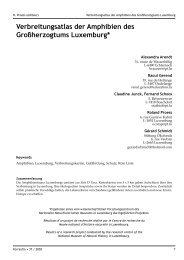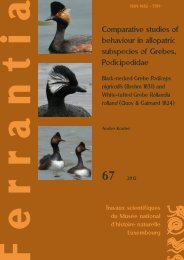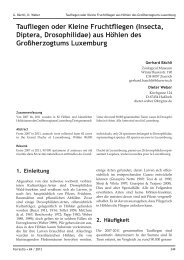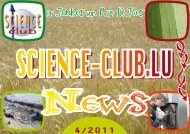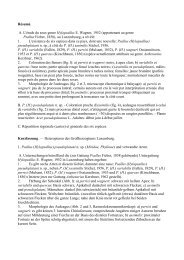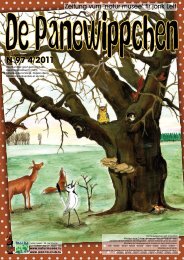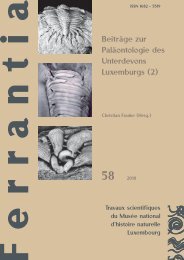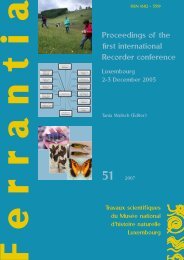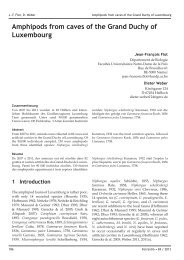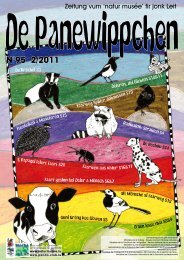Die Fauna der Quellen und des hyporheischen Interstitials in ...
Die Fauna der Quellen und des hyporheischen Interstitials in ...
Die Fauna der Quellen und des hyporheischen Interstitials in ...
Create successful ePaper yourself
Turn your PDF publications into a flip-book with our unique Google optimized e-Paper software.
Gerecke et al. Quell- <strong>und</strong> Interstitialfauna Luxemburgs<br />
<strong>Die</strong> <strong>Fauna</strong> <strong>der</strong> <strong>Quellen</strong> <strong>und</strong> <strong>des</strong> <strong>hyporheischen</strong><br />
<strong>Interstitials</strong> <strong>in</strong> Luxemburg<br />
Unter beson<strong>der</strong>er Berücksichtigung <strong>der</strong> Milben (Acari),<br />
Muschelkrebse (Ostracoda) <strong>und</strong> Ru<strong>der</strong>fusskrebse (Copepoda)*<br />
Abstract<br />
The results of the faunistic survey of 41 spr<strong>in</strong>gs and<br />
30 hyporheic <strong>in</strong>terstitial sites distributed throughout<br />
Luxembourg are presented, with special aention paid<br />
to the follow<strong>in</strong>g representatives of the meiofauna: Acari,<br />
Ostracoda and Copepoda. Of the total number of 143<br />
recorded species (73 Acari, 36 Crustacea Ostracoda and<br />
34 Copepoda), 47 mite and 11 ostracod species are new<br />
to the fauna of Luxembourg; 14 mite and 3 ostracod<br />
species are new to the region 8 of the Limnofauna<br />
Europaea; one mite species, Atracti<strong>des</strong> chelidon Gerecke,<br />
2003 is new to science (because of <strong>in</strong>sufficiencies <strong>in</strong><br />
the present taxonomic knowledge, the correspond<strong>in</strong>g<br />
numbers cannot be given for the copepods). Besi<strong>des</strong>, 9<br />
species of Cladocera, 48 of Mollusca, 4 of Amphipoda,<br />
3 of Isopoda, 2 of Odonata, 11 of Ephemeroptera, 11 of<br />
Ferrantia • 41 / 2005<br />
Re<strong>in</strong>hard Gerecke<br />
Bies<strong>in</strong>gerstr. 11, D-72070 Tüb<strong>in</strong>gen, Germany<br />
re<strong>in</strong>hard.gerecke@uni-tueb<strong>in</strong>gen.de<br />
Fabio Stoch<br />
Viale 25 Aprile 24, I-34015 Muggia (TR), Italy<br />
fabiocop@t<strong>in</strong>.it<br />
Claude Meisch<br />
Musée national d’histoire naturelle de Luxembourg, 25, rue Munster, L-2160 Luxembourg<br />
claude.meisch@education.lu<br />
Isabel Schrankel<br />
Musée national d’histoire naturelle de Luxembourg, 25, rue Munster, L-2160 Luxembourg<br />
ischrankel@mnhn.lu<br />
Plecoptera, 37 of Coleoptera and 44 of Trichoptera are<br />
recorded. One species of Plecoptera and 2 of Trichoptera<br />
are new to the fauna of Luxembourg. The study sites are<br />
<strong>des</strong>cribed and data on the distribution and biology of the<br />
species are given.<br />
For the Acari, Ostracoda and Copepoda the ecological<br />
data are discussed un<strong>der</strong> the follow<strong>in</strong>g po<strong>in</strong>ts of view:<br />
species preference for eu- versus hypocrenal spr<strong>in</strong>g<br />
habitats; limnological spr<strong>in</strong>g typology; impact of habitat<br />
disturbance on species diversity <strong>in</strong> spr<strong>in</strong>gs; comparison<br />
of the results provided by the Bou-Rouch and Karaman-<br />
Chappuis sampl<strong>in</strong>g techniques <strong>in</strong> the <strong>in</strong>terstitial habitat;<br />
variation <strong>in</strong> species distribution throughout Luxembourg <strong>in</strong><br />
relation to the geological substrate; comparison of species<br />
composition <strong>in</strong> spr<strong>in</strong>gs and the <strong>in</strong>terstitial habitat.<br />
*Ergebnisse e<strong>in</strong>es vom wissenschaftlichen Forschungszentrum <strong>des</strong><br />
Nationalen Naturhistorischen Museums <strong>in</strong> Luxemburg durchgeführten Projektes.<br />
Résultats d’un projet de recherche réalisé par le centre de recherche du<br />
Musée national d’histoire naturelle à Luxembourg.<br />
Results of a research project conducted by the research centre of the<br />
National Museum of Natural History <strong>in</strong> Luxembourg.<br />
5
Gerecke et al. Quell- <strong>und</strong> Interstitialfauna Luxemburgs<br />
6<br />
Résumé<br />
Les résultats d’une étude faunistique portant sur 41<br />
sources et le milieu <strong>in</strong>terstitiel de 30 tronçons de cours<br />
d’eau répartis sur tout le Luxembourg sont présentés.<br />
Les représentants suivants de la méiofaune sont étudiés<br />
en détail: Acari, Crustacea Ostracoda et Copepoda.<br />
Parmi les 143 espèces recensées dans ces trois groupes<br />
(73 acariens, 36 ostraco<strong>des</strong> et 34 copépo<strong>des</strong>), 47 espèces<br />
d’acariens a<strong>in</strong>si que 11 espèces d’ostraco<strong>des</strong> sont<br />
nouvelles pour le Luxembourg; 14 espèces d’acariens<br />
et 3 espèces d’ostraco<strong>des</strong> sont nouvelles pour la région<br />
8 de la Limnofauna Europaea; une espèce d’acarien,<br />
Atracti<strong>des</strong> chelidon Gerecke, 2003, est nouvelle pour la<br />
science (pour les copépo<strong>des</strong>, les <strong>in</strong>dications correspondantes<br />
ne peuvent être données pour cause de<br />
problèmes taxonomiques non encore résolus dans ce<br />
groupe). De plus, 9 espèces de cladocères, 48 espèces de<br />
mollusques, 4 d’amphipo<strong>des</strong>, 3 d’isopo<strong>des</strong>, 2 d’odonates,<br />
Zusammenfassung<br />
<strong>Die</strong>se Arbeit gibt e<strong>in</strong>en Überblick über die <strong>Fauna</strong> von 41<br />
<strong>Quellen</strong> <strong>und</strong> 30 Interstititial-Probestellen <strong>in</strong> allen Teilen<br />
Luxemburgs. Ausgewählte Vertreter <strong>der</strong> Meiofauna<br />
(Acari, Crustacea Ostracoda <strong>und</strong> Copepoda) wurden<br />
beson<strong>der</strong>s berücksichtigt. Von den <strong>in</strong>sgesamt 143<br />
Arten dieser Gruppen (73 Acari, 36 Ostracoda <strong>und</strong> 34<br />
Copepoda) wurden 47 Acari- <strong>und</strong> 11 Ostracoda-Arten<br />
erstmals <strong>in</strong> Luxemburg nachgewiesen, 14 Acari- <strong>und</strong><br />
3 Ostracoda-Arten s<strong>in</strong>d auch neu für die Region 8 <strong>der</strong><br />
Limnofauna Europaea, <strong>und</strong> e<strong>in</strong>e Acari-Art, Atracti<strong>des</strong><br />
chelidon Gerecke, 2003 ist neu für die Wissenscha (für<br />
die Copepoda s<strong>in</strong>d entsprechende Angaben aufgr<strong>und</strong><br />
ungelöster taxonomischer Probleme <strong>der</strong>zeit nicht<br />
möglich). Desweiteren wurden 9 Arten <strong>der</strong> Cladocera,<br />
48 <strong>der</strong> Mollusca, 4 <strong>der</strong> Amphipoda, 3 <strong>der</strong> Isopoda, 2 <strong>der</strong><br />
Ordonata, 11 <strong>der</strong> Ephemeroptera, 11 <strong>der</strong> Plecoptera, 37<br />
<strong>der</strong> Coleoptera <strong>und</strong> 44 <strong>der</strong> Trichoptera nachgewiesen.<br />
11 d’éphémères, 11 de plécoptères, 37 de coléoptères et<br />
44 de trichoptères sont recensées.<br />
Une espèce de plécoptères et 2 de trichoptères sont<br />
nouvelles pour le Luxembourg. Les sites de prélèvement<br />
sont décrits et <strong>des</strong> <strong>in</strong>dications sur la distribution et l’écologie<br />
de chacune <strong>des</strong> espèces sont données.<br />
Pour les acariens, ostraco<strong>des</strong> et copépo<strong>des</strong> les po<strong>in</strong>ts<br />
suivants sont discutés: Certa<strong>in</strong>es espèces ont-elles une<br />
préférence pour le tronçon eucrénal ou hypocrénal <strong>des</strong><br />
sources? Une typologie limnologique <strong>des</strong> sources estelle<br />
possible? L’altération de l’état naturel d’une source<br />
<strong>in</strong>fluence-t-elle sa diversité faunistique? Les techniques<br />
de prélèvement de Bou-Rouch et de Karaman-Chappuis<br />
dans le milieu <strong>in</strong>terstitiel donnent-elles <strong>des</strong> résultats<br />
comparables? Le substrat géologique <strong>in</strong>fluence-t-il la<br />
répartition <strong>des</strong> espèces étudiées? Les sources et le milieu<br />
<strong>in</strong>terstitiel <strong>des</strong> cours d’eau ont-ils une faune semblable?<br />
E<strong>in</strong>e Plecoptera-Art <strong>und</strong> 2 Trichoptera-Arten s<strong>in</strong>d neu<br />
für Luxemburg. Alle Untersuchungsstellen werden<br />
beschrieben, jede Art wird h<strong>in</strong>sichtlich wichtiger Details<br />
ihrer Verbreitung <strong>und</strong> Biologie vorgestellt.<br />
Für die Acari, Ostracoda <strong>und</strong> Copepoda werden <strong>in</strong><br />
e<strong>in</strong>er ökologischen Analyse <strong>der</strong> erhobenen Daten die<br />
folgenden Gesichtspunkte besprochen: Eventuelle<br />
Präferenz e<strong>in</strong>zelner Arten für Eu- o<strong>der</strong> Hypokrenal-<br />
Abschnie <strong>in</strong>nerhalb <strong>der</strong> <strong>Quellen</strong>; limnologische<br />
Quelltypologie; Bedeutung von Störungen für die<br />
Artenvielfalt <strong>in</strong> <strong>Quellen</strong>; Vergleich zwischen den Bou-<br />
Rouch- <strong>und</strong> Karaman-Chappuis-Sammelmethoden<br />
im Interstitial; faunistische Unterschiede zwischen<br />
e<strong>in</strong>zelnen Lan<strong>des</strong>teilen vor dem H<strong>in</strong>tergr<strong>und</strong> <strong>des</strong> geologischen<br />
Untergr<strong>und</strong>s; Ähnlichkeiten <strong>und</strong> Unterschiede<br />
zwischen den Faunen von Quellhabitaten e<strong>in</strong>erseits <strong>und</strong><br />
Interstitialhabitaten an<strong>der</strong>erseits.<br />
Ferrantia • 41 / 2005



